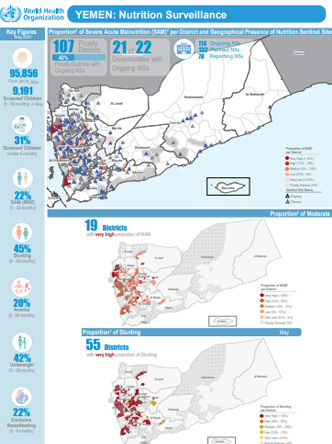The ongoing conflict and resulting economic crisis are the main drivers of food insecurity in Yemen leaving the country’s critical civil infrastructure in ruins.
To save lives, WHO, in collaboration with local health authorities and, through the Emergency Health and Nutrition Project funded by the World Bank have established a nutrition surveillance system to find and refer for the appropriate treatment all children affected by acute malnutrition. The nutrition surveillance system prioritizes and closely monitor communities at elevated risk of famine. The system is designed to find the lives we so desperately need to save.
Nutritional assessment in the nutrition surveillance system is normally performed through the measurement of child’s weigh, height/length, measurement of upper arm circumference, age, haemoglobin level, breastfeeding status and oedema. It is a Facility-based surveillance system, established mainly in district hospitals across the country. The system provides the proportions of children under five years found suffering from any forms of malnutrition, out of the total children screened. The results only reflect the status of children who have attended the health facility in the month under review. The system tracks 4 out of 6 global core nutrition indicators: stunting, wasting, exclusive breastfeeding, and anaemia.
In 2020 because of COVID-19 to mitigate the risk of hospital-acquired infection, adapted protocol have been put in place to ensure safe screening services and minimize cross infections while performing a correct assessment. Therefore, some indicators, e.g. acute malnutrition by weight-for-height Z-score and stunting, were temporarily excluded from the set of measurements, as an interim measure to control the spread of infection, although the use of anthropometric tools is safe after sanitization. Currently, although some sites are still following these operating procedures, most of the sentinel sites have resumed the assessment of all indicators.
Each month a bulletin is produced and widely shared with all stakeholders at national, regional, and global level for information sharing and to support decision-making.
Key actions in 2021
From January to February 2021, 134 247 children under 5 years were screened for malnutrition across the 249 nutrition surveillance sites established in Yemen.
For the month of February, 63 345 were screened with 23% were under 6 months of age. 22% were found suffering from wasting and referred to the appropriate nutrition programmes, Hodidah had the highest proportions of acute malnutrition, and 47% were underweight.
Chronic malnutrition (stunting) remains of high concern affecting 44% of screened children and reflected in high proportions in 149 districts. 19% of 6-59 month children have anemia, and exclusive breastfeeding among infants under 6 months of age shows very low average rates 15% which still lags behind the WHO global targets 2025 (at least 50%) suggesting causal linkages between sub-optimal breastfeeding practices and high levels of acute and chronic malnutrition.










